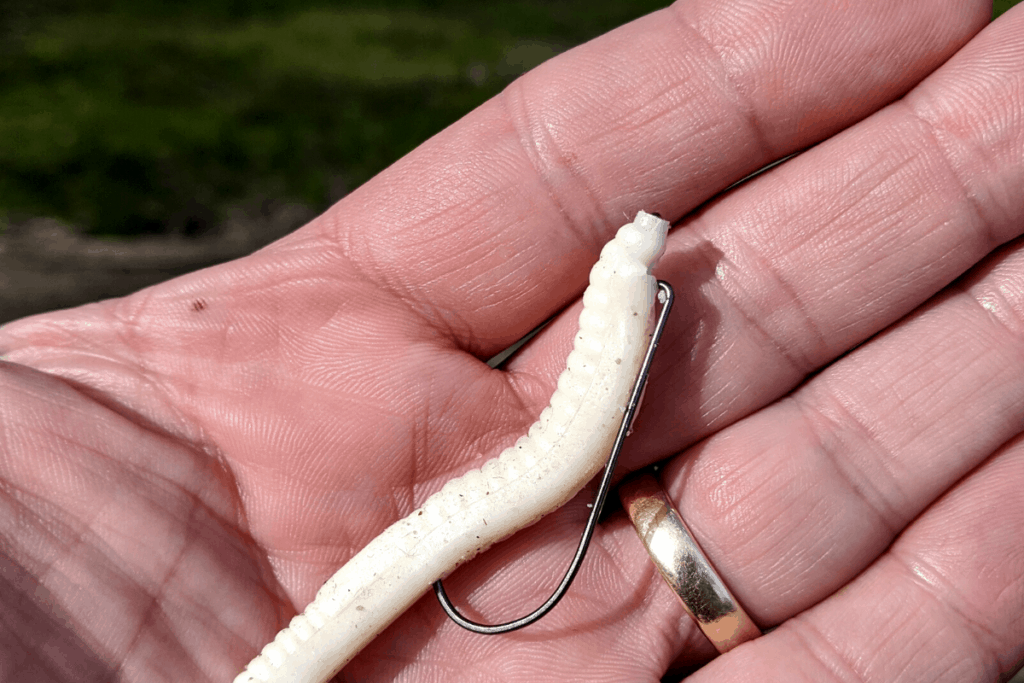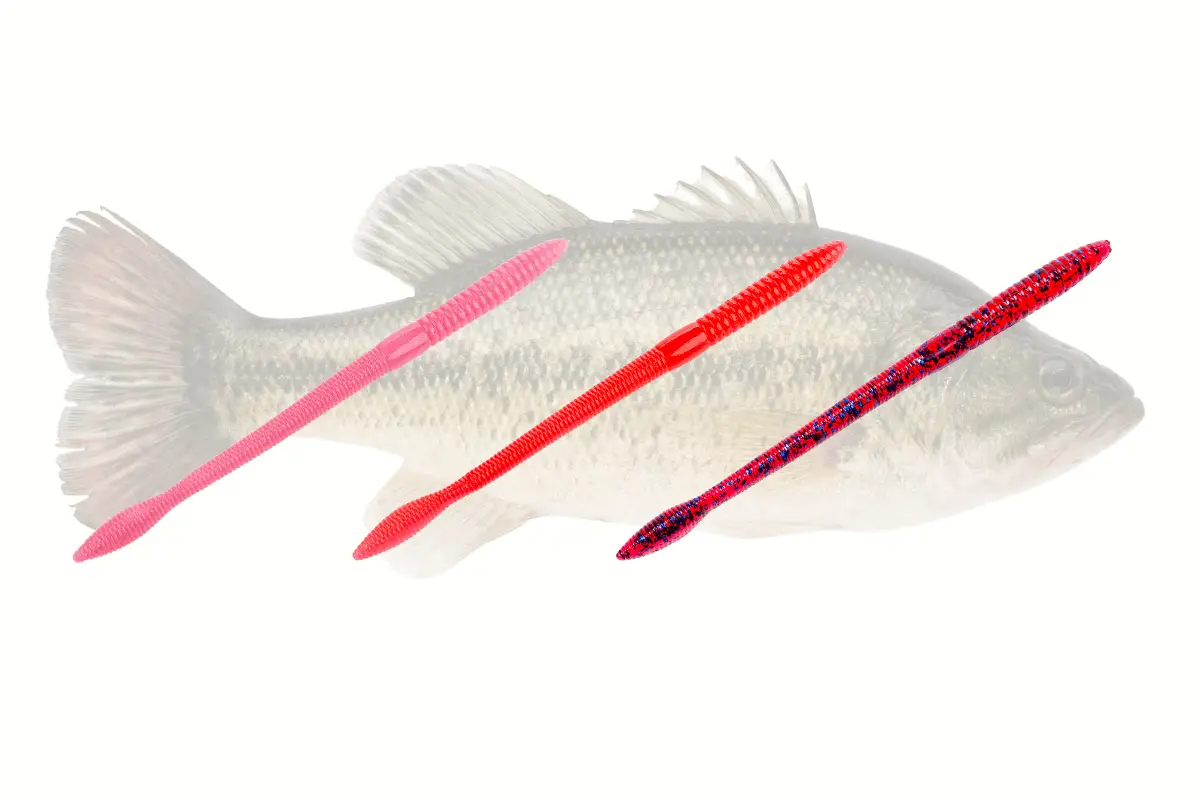A floating worm in the springtime has been a staple when bass move shallow. In recent years the popular method has taken a backseat to newer and flashier techniques. Pick one up and give it a shot and you will have yourself a spring bass magnet.
To fish a floating worm in the spring anglers need to know bass have moved shallow. Choose a color that is highly visible and rig it Texas-style. Fish it with a twitch-twitch-pause method and be ready to use a side-sweep hookset.
In this article, the complete rigging and presentation of a floating worm will be covered. Give it a shot and you may find a new favorite spring technique.
1. When to Fish a Floating Worm
This is a method that shines when bass have started to move shallow in the early spring.
As you move down the shore when fishing keep an eye out for signs of life in the shallows. When there are panfish, minnows, and other small bass cruising in skinny water a floating worm can work wonders.
This method works best in water with some visibility because it can draw fish from a distance. The solid shock colors do work in dirty or stained water, but the clearer the more effective it can be.
As the water warms up in the spring it is a good idea to have a floating worm always rigged up on one rod. Conditions change in the prespawn overnight and zero fish in the shallows one day can be followed by hundreds that have moved up overnight.

2. Lure Color
Traditional floating worm colors are bright, gaudy, and are labeled as shock colors.
Some popular choices include methiolate, hot chartreuse, bubble gum, and white. Natural colors always work as well, but part of the fun of fishing with floating worms is seeing the lure and knowing when the bass inhale it.
There is a school-of-thought that believes the shock colors entice the bass into biting. Other folks feel the shock colors are just there for visibility.
I tend to fall into the latter category since fishing a floating worm is a shallow water technique, but I have no doubt that there are times when a methiolate worm may do better than a green pumpkin offering.
This is an excellent time to have another angler in the boat and experiment with color. Which one is getting better bites?
Keep throwing different color variations until you find one that not only triggers the most strikes, but the strongest.

3. Rigging a Floating Worm
This is where there are several options an angler can employ.
A floating worm is Texas Rigged, but the options from there are wide-open and can be tweaked to your own preference.
The traditional offset hook in a 3/0 or 4/0 model is a good choice.
There are two methodologies on the rigging of the worm. Some anglers prefer to keep the worm straight, as you would with a traditional Texas Rig, other anglers love to put a kink or bend, in the worm.
The thought behind throwing a bend in the worm is that it helps create a side-to-side action that drives bass crazy. To throw a bend in the plastic, hold the hook where you would normally line it up to rig it straight, then grab it a ½ in farther back to insert the point. This will give it that J-bend look.
Many anglers also like to use a nail weight to help with casting and the sink rate. The nail should be placed at the front of the worm between the eye of the hook and the point. The worm wants to fall with a front-down approach, not a backward slide that would happen if the nail was slipped in the rear of the worm.
Leader and Swivel
If you find that line twist is an issue, using a barrel swivel up the line is an option.
Some anglers also prefer this to add a little weight to make casting easier.
There are a variety of line options, but I prefer braid to a fluoro leader combination. I like the way braid casts and I use the leader because of fishing in clear water, but straight mono or fluoro works as well.
If you want to achieve the slowest fall rate, mono or braid will be a better choice since they float.
If it is real windy, fluorocarbon may be the better option because it sinks and is heavier. This allows it to slice through the wind more efficiently.
4. Rod and Reel Selection for a Floating Worm
I use casting gear with a floating worm but spinning gear is popular because a light lure can be difficult to cast. The accuracy of baitcast equipment is why I prefer it.
A medium-heavy power rated rod is a good choice because the single hook presentation needs some backbone to transfer energy to the hookset.
A moderate tip, or action, is a nice touch to help with casting the light lure. A tip that is too stiff doesn’t allow the proper touch to place a floating worm where you want it to go.
5. Floating Worm Presentation
The standard twitch-twitch-pause retrieve is a good place to start, but fishing a floating worm takes some experimenting.
The bass will let you know what they want on a particular day.
There are times when they respond better to a more continuous twitching presentation, yet there other days when a long pause is the ticket to getting more bites.
If the bass are only swiping at the lure or following it without committing, that is a sign that the cadence and retrieve should be adjusted.
When the bass start to fully engulf the lure and swipe at it with some attitude, you are on the right track for that particular day.
Keep adjusting and altering the retrieve until you dial in what is working well.
6. Hookset
This is where fishing a floating worm can be more challenging, especially in clear water with bright colors.
If an angler is watching a bright, methiolate worm come through the water it is easy to tell when a bass inhales it. The lure suddenly vanishes.
Since an angler sees the lure disappear, they often swing away with an immediate hookset. The result? A missed fish.
If you are watching the lure and see it vanish, hesitate until you feel some pressure, then proceed to set the hook with a side-sweep motion.
It is a very similar hookset to frog fishing.
If the water you are fishing is dirtier and visibility is an issue, then you naturally won’t set the hook until you feel pressure anyway.
Final Thoughts
Fishing a floating worm is fun. This springtime tradition is something that anglers have enjoyed for decades, yet it is often overlooked with all the options available today.
There is a chance that you may be working down the shoreline and catch fish others miss because it is something different that the bass may not have seen yet.
Just be sure to keep the following in mind:
- Fish it When the Bass are Shallow
- Experiment with color – Don’t Be Afraid to Use Shock Colors
- Rig it Texas style with or without a nail weight
- Use a Medium-Heavy power rated rod
- Vary the Retrieve Until the Bass Commit
- Wait to Set the Hook Until You Feel Pressure
Good luck with the floating worm this spring. It is a classic that has been fooling bass for a long time.
There is something about watching a lunker come up and inhale that brightly colored lure that makes it magical.
Tight lines. Be safe and don’t forget to encourage someone today. You never know how you may just change their life forever.
Isaiah 6:8

